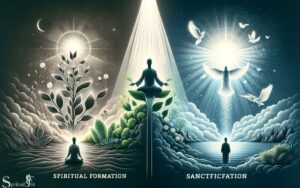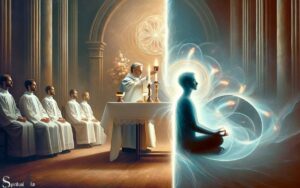Kemetic Spirituality Vs Christianity: Rituals!
Comparing Kemetic Spirituality and Christianity reveals profound differences in origins, deities, beliefs, rituals, and cultural impacts. These two belief systems, while both influential, diverge in their historical development and spiritual teachings.
Kemetic spirituality, rooted in ancient Egypt, focuses on polytheism and living in harmony with Ma’at (cosmic order), whereas Christianity is a monotheistic religion centered around the life and teachings of Jesus Christ.
Kemetic spirituality is an ancient Egyptian religion that dates back to predynastic times, emphasizing the worship of multiple gods and goddesses, each representing aspects of nature and human experience. It is characterized by practices aimed at maintaining balance with Ma’at.
Christianity, in contrast, originated in the 1st century CE in the Levant region of the Middle East, with Jesus of Nazareth at its core, and it centers on the belief in one God and the salvation of humanity through Jesus’ death and resurrection.
Origins: – Kemetic Spirituality: Ancient Egypt – Christianity: 1st century CE, Levant
Deities: – Kemetic: Multiple gods (e.g., Osiris, Isis, Horus) – Christianity: One God
Key Beliefs: – Kemetic: Harmony with Ma’at, afterlife based on earthly deeds – Christianity: Salvation, resurrection, eternal life through Christ
Rituals: – Kemetic: Offerings, festivals, and temple services – Christianity: Baptism, Eucharist, prayer, and church services
Delving into the core principles of Kemetic spirituality and Christianity offers a window into the philosophical diversity of human spirituality and how it shapes our worldviews.
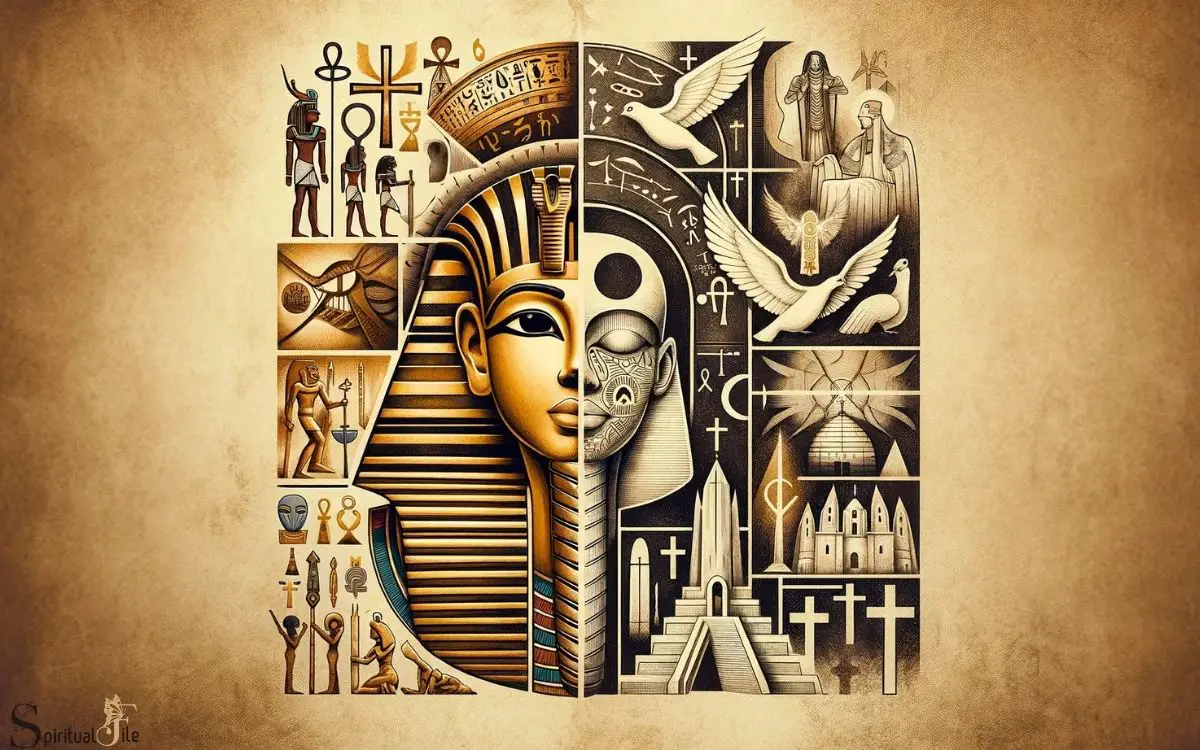
Key Takeaway
10 Criteria’s About Kemetic Spirituality and Christianity
| Criteria | Kemetic Spirituality | Christianity |
|---|---|---|
| Origin | Ancient Egypt | Ancient Palestine, after the death and resurrection of Jesus Christ |
| Key Beliefs | Polytheistic, believed in life after death and divine justice | Monotheistic, belief in Jesus Christ as Savior, belief in Heaven and Hell |
| Practices | Offerings, rituals, and invocation of deities | Church worship, sacraments such as baptism and communion, prayer |
| Divine Beings | Numerous gods and goddesses, such as Ra, Isis, Osiris | One God in three persons: Father, Son (Jesus Christ), and Holy Spirit |
| Sacred Texts | Pyramid Texts, Coffin Texts, Book of the Dead | The Holy Bible: Old Testament and New Testament |
| Concept of the Afterlife | Believed in an afterlife where the soul would be judged by Ma’at | Belief in eternal life in Heaven for believers, eternal separation from God for non-believers |
| Moral & Ethical Guidelines | Ma’at, concept of truth, balance, order, harmony, law, morality, and justice | The Ten Commandments, the teachings of Jesus as outlined in the New Testament |
| Relationship With Divine Beings | Direct communication with the deities through invocations and offerings | Personal relationship with God through prayer and worship |
| Influence on Society | Influenced ancient Egyptian civilization, art, and culture | Influenced Western civilization, thought, law, ethics, and culture |
| Current Followers | Revived practice with followers across the globe | Estimated over 2 billion followers worldwide |
Origins and Historical Background
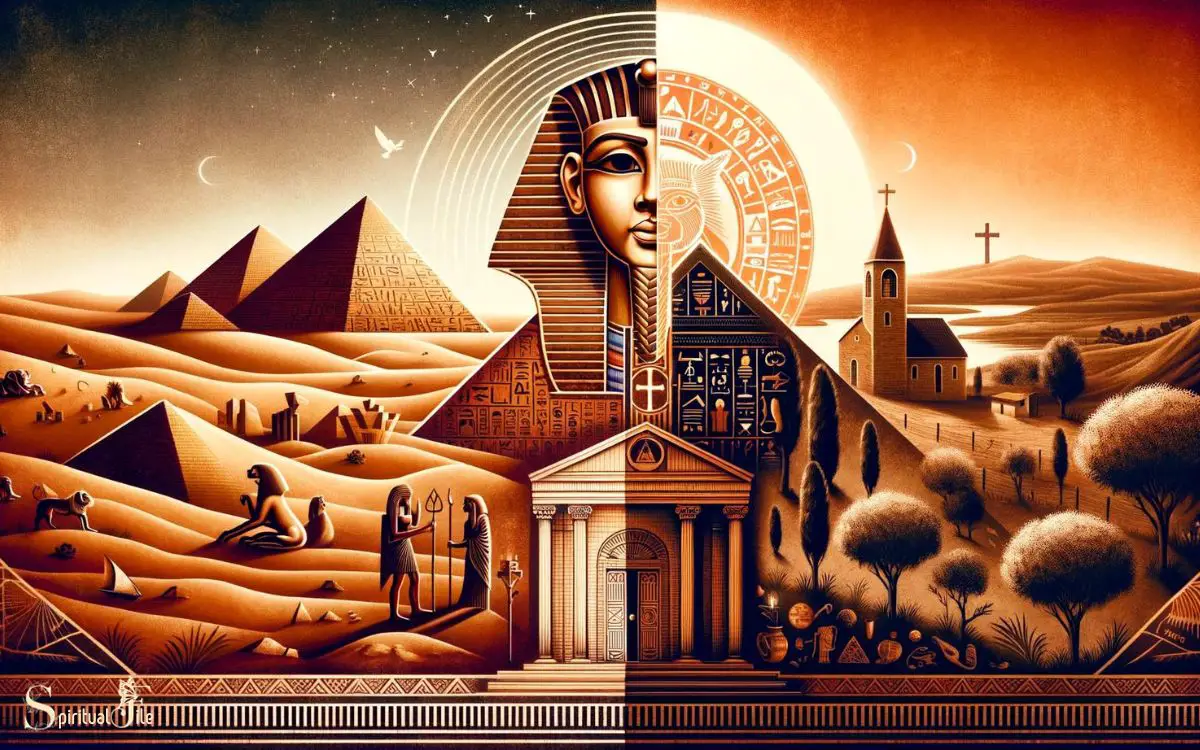
The origins and historical background of Kemetic spirituality and Christianity can be traced back through millennia to the ancient civilizations of Egypt and the Near East.
Kemetic spirituality, also known as Kemetism, is derived from the religious practices of ancient Egypt, dating back to around 3000 BCE. It encompassed a complex belief system, ritualistic practices, and a pantheon of deities.
Christianity, on the other hand, emerged from the teachings of Jesus Christ in the 1st century CE in the Near East. It spread rapidly throughout the Roman Empire and eventually became the dominant religion in the West.
Both belief systems have been influenced by the cultural, social, and political dynamics of their respective time periods, shaping the spiritual landscape of humanity over the centuries.
Understanding their historical roots provides insight into the development of these enduring faith traditions.
Key Beliefs and Practices
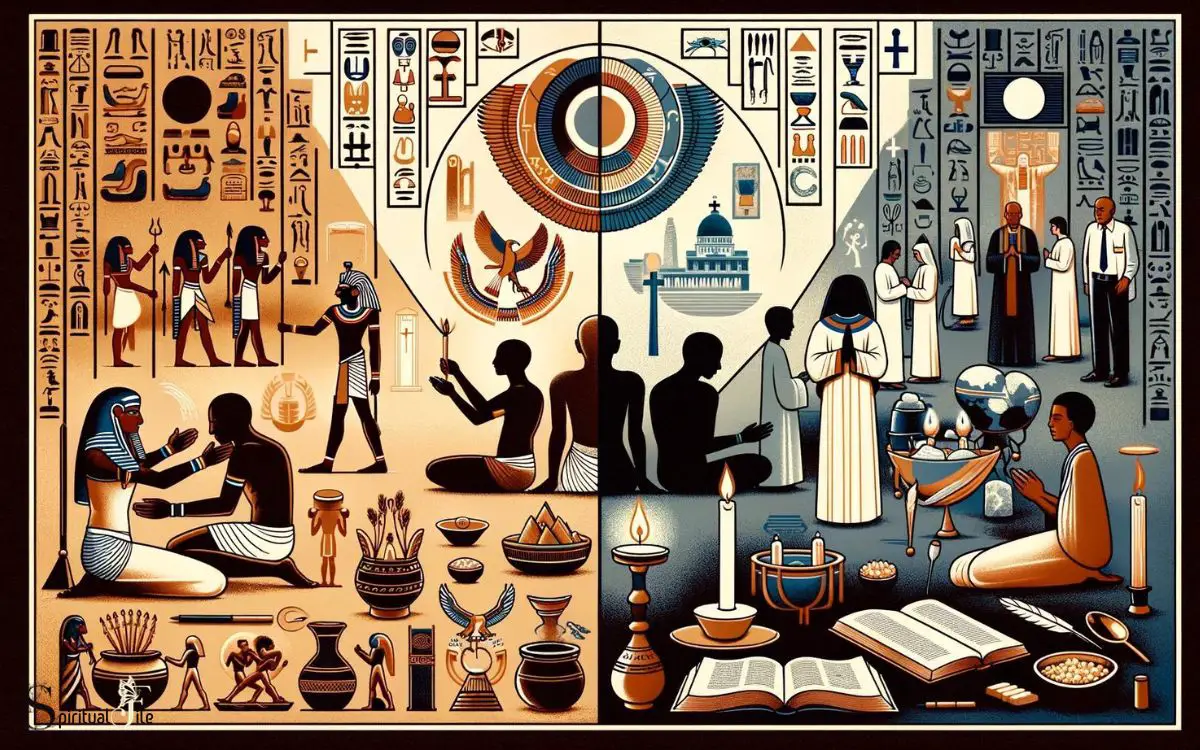
In Kemetic spirituality, the veneration of a diverse pantheon of deities and the practice of ritualistic ceremonies were central to the religious beliefs and practices, while in Christianity, the monotheistic worship of one God and the sacramental rituals hold paramount significance.
| Key Beliefs and Practices | Kemetic Spirituality | Christianity |
|---|---|---|
| Deities | Multiple gods and goddesses representing natural elements and aspects of life. | One God, representing the Holy Trinity: Father, Son, and Holy Spirit. |
| Afterlife | Emphasis on achieving immortality through the preservation of the spirit and body. | Belief in an afterlife with salvation through faith in Jesus Christ. |
| Rituals | Rituals for honoring the gods, performing offerings, and maintaining cosmic order. | Sacraments, including baptism and communion, as means of receiving God’s grace. |
| Ethics | Emphasis on maintaining Ma’at (truth, justice, and harmony) in personal and social conduct. | Moral teachings based on the Bible and the life of Jesus Christ. |
Deities and Spiritual Entities
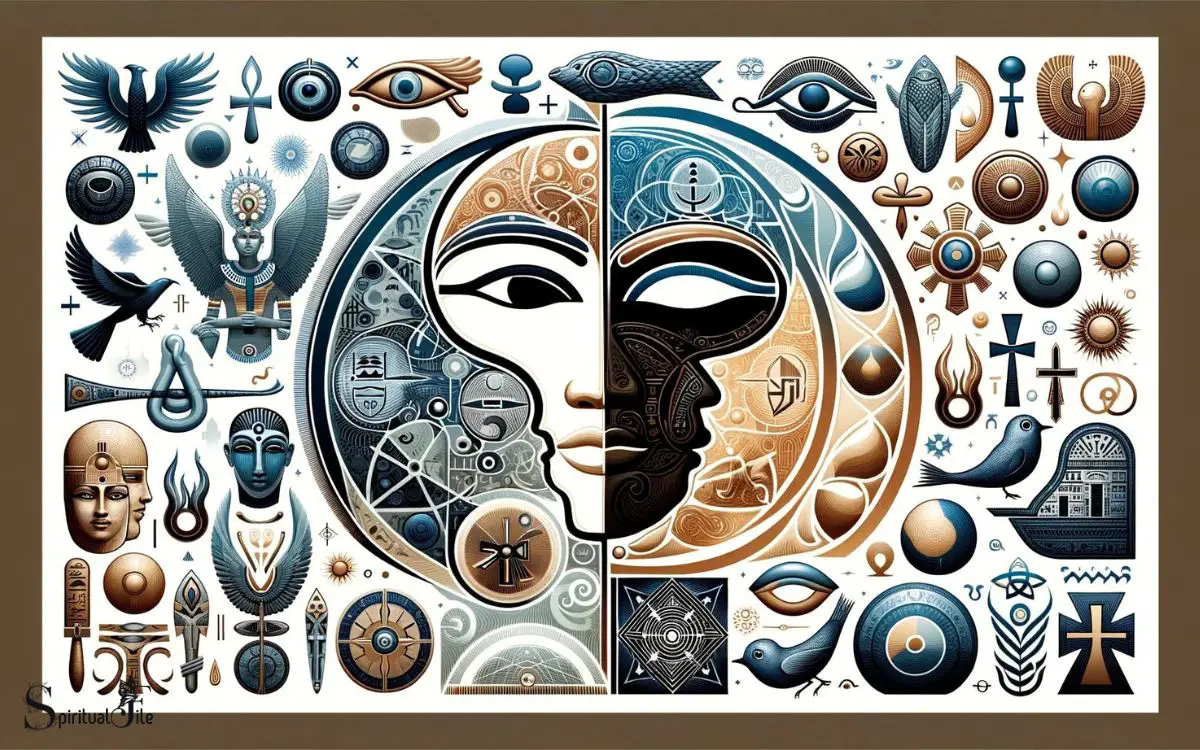
Veneration of a diverse pantheon of deities and the practice of ritualistic ceremonies are integral to Kemetic spirituality, and are contrasted with the monotheistic worship of one God in Christianity.
In Kemetic spirituality, deities are seen as distinct entities with their own personalities, attributes, and roles in the universe. They are honored through prayers, offerings, and rituals aimed at establishing a connection with the divine.
Additionally, spiritual entities such as ancestors and nature spirits are also revered in Kemetic practices.
In contrast, Christianity emphasizes the worship of one God, who is believed to be omnipotent, omniscient, and omnipresent. This monotheistic belief shapes the religious practices of Christianity, where prayers and worship are directed solely towards this singular deity.
Rituals and Ceremonies
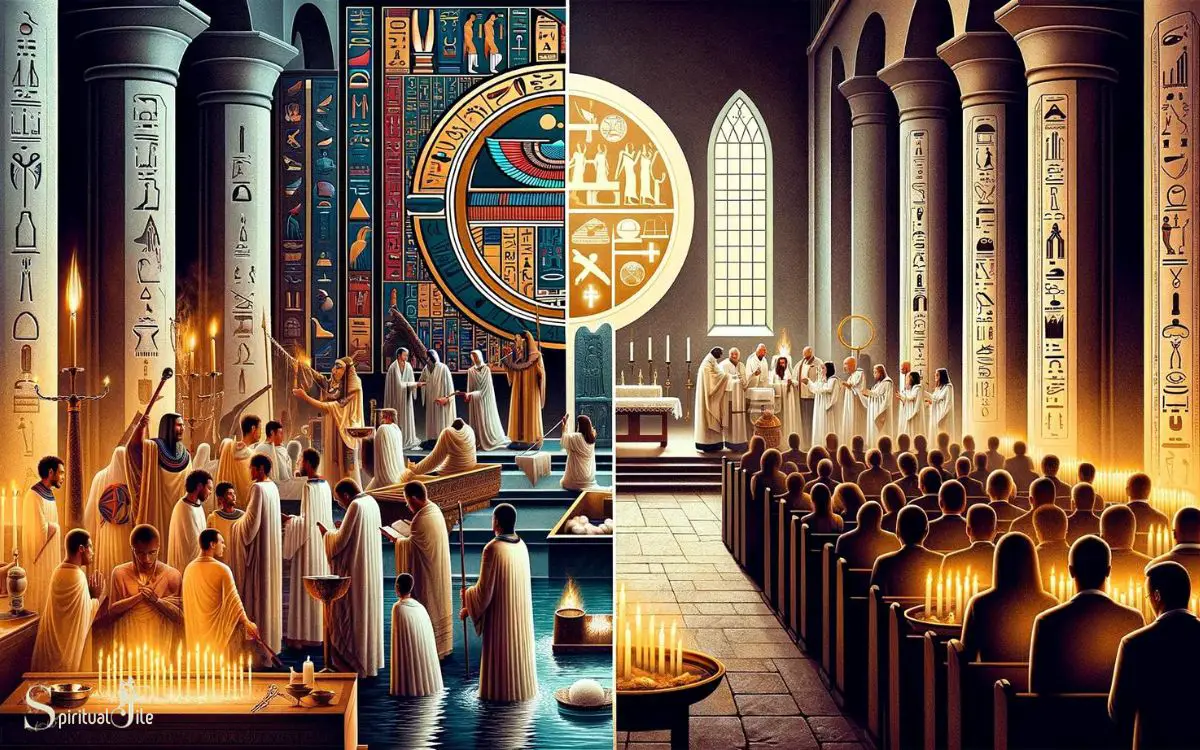
Rituals and ceremonies in Kemetic spirituality involve the veneration of a diverse pantheon of deities and the practice of honoring spiritual entities, which contrasts with the monotheistic worship of one God in Christianity.
The rituals in Kemetic spirituality are deeply rooted in ancient Egyptian traditions and are aimed at maintaining harmony and balance in the earthly and divine realms.
These rituals often include offerings, prayers, and symbolic gestures to express reverence and gratitude towards the deities.
In contrast, Christian ceremonies primarily revolve around the worship of the one God, often involving sacraments such as baptism, communion, and confession.
The following table summarizes the key differences in rituals and ceremonies between Kemetic spirituality and Christianity:
| Aspect | Kemetic Spirituality | Christianity |
|---|---|---|
| Number of Deities | Veneration of a diverse pantheon of deities | Monotheistic worship of one God |
| Ritual Practices | Offerings, prayers, and symbolic gestures | Sacraments such as baptism, communion, confession |
Influence on Modern Society
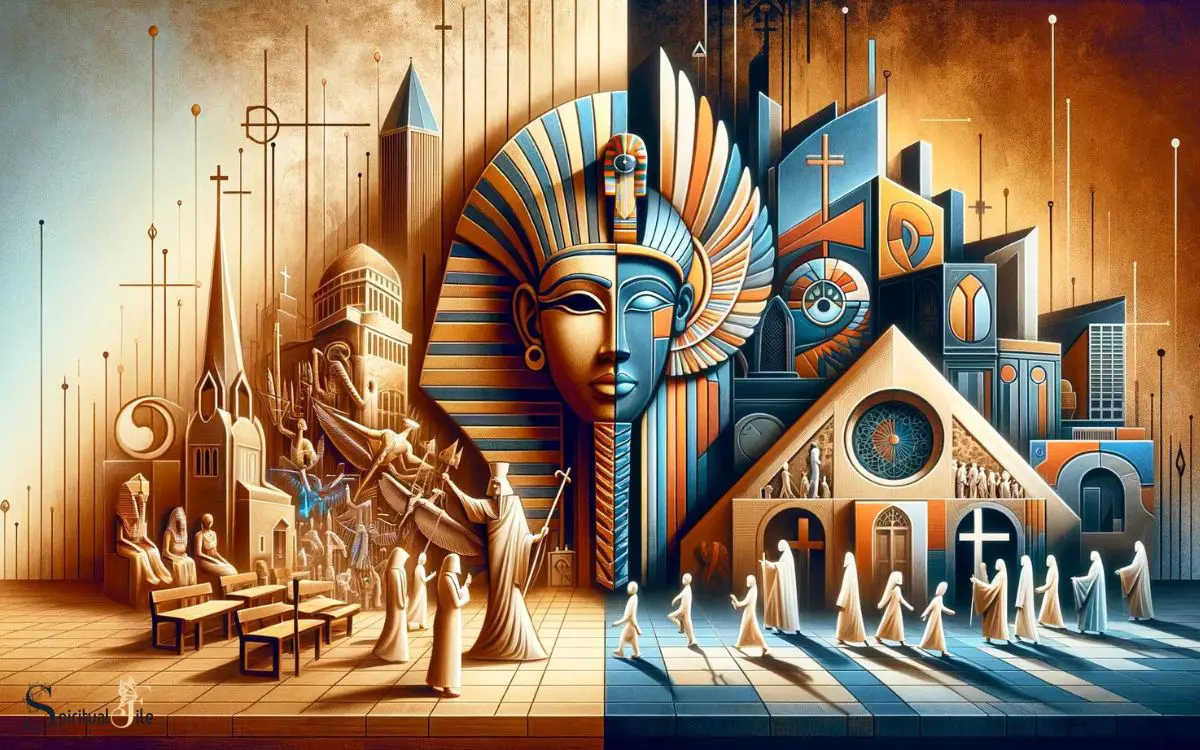
The impact of Kemetic spirituality and Christianity on modern society is reflected in their influence on cultural practices and belief systems.
Kemetic spirituality, with its focus on harmony with nature and the concept of Ma’at, has influenced modern holistic and environmental movements.
Additionally, Kemetic symbols and deities have found their way into popular culture, art, and fashion, reflecting a broader societal interest in ancient Egyptian spirituality.
On the other hand, Christianity’s influence on modern society can be seen in its impact on ethical and moral frameworks, as well as its influence on art, literature, and music. The Christian calendar and holidays also play a significant role in shaping the rhythm of modern life.
Both Kemetic spirituality and Christianity continue to shape and influence various aspects of modern society, reflecting the enduring impact of these ancient belief systems.
How Do Rituals in Kemetic Spirituality Compare to the Spiritual Meaning of Gemstones in Malachite and Moldavite?
Rituals in Kemetic spirituality hold deep significance, just like the malachite and moldavite spiritual meanings. Both traditions emphasize the importance of spiritual connection and personal growth. While Kemetic rituals focus on honoring deities and ancestors, malachite and moldavite are used for healing and spiritual evolution.
Frequently Asked Questions
How Do Kemetic Spirituality and Christianity View the Concept of Sin and Redemption Differently?
Both Kemetic spirituality and Christianity approach the concept of sin and redemption from distinct theological perspectives.
While Kemetic spirituality emphasizes personal responsibility and inner balance, Christianity emphasizes sin as disobedience to God and redemption through faith in Jesus Christ.
Are There Any Specific Dietary Restrictions or Practices in Kemetic Spirituality That Differ From Christianity?
In Kemetic spirituality, dietary practices often focus on honoring the gods and maintaining purity through food offerings and abstaining from certain substances.
This differs from Christianity, where dietary restrictions are less emphasized and vary among different denominations.
What Is the Role of Gender and Sexuality in Kemetic Spirituality Compared to Christianity?
Gender and sexuality in Kemetic spirituality are often seen as interconnected with the divine and are valued for their unique contributions to society.
This contrasts with some interpretations of Christianity, where traditional gender roles and sexual norms hold significant influence.
How Do Kemetic Spirituality and Christianity Approach the Afterlife and Concepts of Heaven and Hell?
Kemetic spirituality and Christianity approach the afterlife and concepts of heaven and hell differently.
In Kemetic spirituality, the afterlife is seen as a continuation of life, whereas in Christianity, it is based on reward or punishment.
Are There Any Specific Symbols or Sacred Texts in Kemetic Spirituality That Are Not Found in Christianity?
In exploring the symbols and sacred texts of Kemetic spirituality, we encounter unique representations of cosmic forces and deities.
These symbols and texts offer profound insights into the spiritual beliefs and practices of this ancient tradition.
Conclusion
Kemetic spirituality and Christianity have both played significant roles in shaping the beliefs and practices of their followers.
Kemetic spirituality is rooted in ancient Egyptian traditions and reverence for natural forces. It emphasizes the interconnectedness of all things and the importance of maintaining harmony with the natural world.
This spiritual path involves rituals, prayers, and offerings to the gods and goddesses of ancient Egypt. It also places a strong emphasis on ancestor veneration and the belief in an afterlife.
On the other hand, Christianity is based on the teachings of Jesus Christ and the monotheistic belief in God.
It centers around the life, death, and resurrection of Jesus, and the belief that he is the son of God and the savior of humanity. Christians worship in churches, read and study the Bible, and engage in practices such as prayer, baptism, and communion.
Despite their differences, both Kemetic spirituality and Christianity have influenced modern society in various ways. They have shaped art, architecture, literature, and music. They have also provided individuals with a sense of meaning, purpose, and community.
In the end, the existence of multiple spiritual paths highlights the diversity and complexity of human beliefs and experiences.
It reminds us that there is no one-size-fits-all approach to matters of faith and spirituality. Instead, it encourages us to embrace and respect the various ways in which individuals seek connection with the divine.


